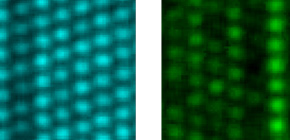
New chemically-ordered structures at ceramic grain boundaries found
New guidelines for developing high-quality ceramic materials
Zirconia ceramics (ZrO 2 ) are used for solid electrolytes in fuel cells and different elements including yttrium (Y) are added to improve their ceramic properties. Added Y increases ion conductivity in crystal; however, when it segregates at an interface such as a grain boundary, it interferes with ion conductivity in the grain boundary. Because of this reason, grain boundary segregation of different elements has been thought to be a major cause of deterioration of cell properties. In order to increase the quality of solid electrolytes, it is necessary to clarify the nature of this phenomenon and control it appropriately.
A group of researchers led by Associate Professor SHIBATA Naoya, Professor IKUHARA Yuichi, Specially Appointed Researchers Feng Bin and KUMAMOTO Akihito (Institute of Engineering Innovation, The University of Tokyo), jointly with Associate Professor YOSHIYA Masato and Specially Appointed Researcher YOKOI Tatsuya (Department of Adaptive Machine Systems, Graduate School of Engineering, Osaka University), clarified the atomic structure of Y segregation in ZrO grain boundaries by using a scanning transmission electron microscope (STEM) and ultra-sensitive X-ray composition analysis. As a result, it was clarified that Y atoms did not segregate irregularly at grain boundaries but formed unique chemically-ordered structures at an atomic level.
This structure corresponds with the structure predicted by theoretical calculations, and it was clarified that it was a new phase formed at grain boundaries alone through mutual interaction between grain boundary structure, Y, and oxygen vacancy.
These results give us basic knowledge at an atomic level regarding how different elements added to ceramics distribute at interfaces such as grain boundaries and how they affect functions and properties of grain boundaries, making them important results to provide guidelines for developing high-performance solid electrolytes .

Figure 1

Figure 2

Figure 3
To learn more about this research, please view the full research report entitled " Atomically ordered solute segregation behaviour in an oxide grain boundary " at this page of the Nature Communications website.
Related link

